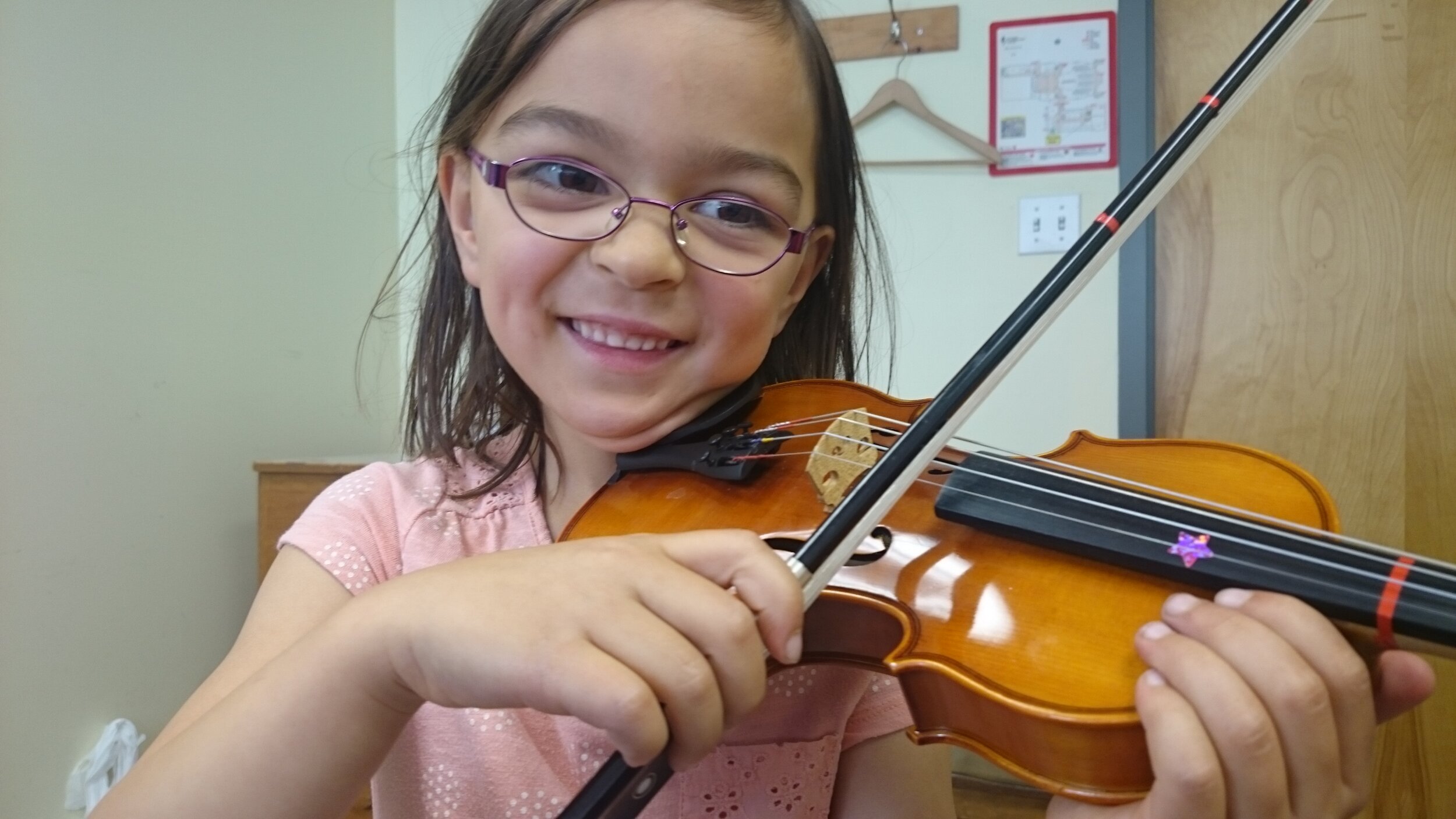Suzuki & Traditional
Briefly, what are the biggest differences?
Briefly, what are the biggest differences?

Parent Involvement in Suzuki
Much like when a child learns to talk, parents are involved also in the musical learning of their Suzuki child; to support, guide, and encourage. They attend lessons with the child and serve as “home helpers” during daily practices throughout the week. One parent often learns to play the instrument along with their child, so that s/he understands what the child is experiencing and even play the “student” to provide motivation. Parents work with the teacher to create an enjoyable learning environment. Many parents report years later that this quality time spent together in lessons and practices were some of their most treasured moments! Suzuki Triangle
Parental Involvement in Traditional
Most often having very little to no parental involvement. Parents usually drop their child off, a few passing words are exchanged, but music is usually placed in the hands of the teacher and child only, and the success or failure of the musical experience is often child based - on wether or not they like their teacher or make time to practice. We often hear kids saying, “X instrument just wasn’t for me.” Now that may be true, but the influence of a good, connected, involved teacher and parent can make all the difference.

Early Beginning in Suzuki
The early years are crucial for developing mental processes and muscle coordination. Because Suzuki focuses in the early years on learning by ear, emulation & repetition (training early-on a sense of pitch, rhythm, and coordination), it is perfect for the young mind to comprehend; and formal training can begin as early as two and a half (but it is never too late to start!). Many find that starting so early results in children rarely quitting - as they do not remember a time without the instrument, and though progress is slower when children begin so young, it is built into their very cells. Once the teen years come, they have already solid skills they are proud of, and often a strong community of like-minded peers.
Beginning and Traditional
Usually encouraging children to begin around 7-10 years old (after most verbal neurones have been formed) - old enough to read music. Though progress will be quicker, the “engrained” feeling that comes from training rhythm into the body - rather than intellectually learning rhythm (some for the first time) will not be there and will require time and sometimes hard focus; often causing disinterest due to the high level of conscious effort and difficulty it takes to learn. Drop-out rates if “self mastery” has not been created before the early teen years, skyrocket - because there is so much to learn between the beginning (7-10yo) and mastery!

Delayed Note Reading in Suzuki
Children learn to read after their ability to talk has been well established. In the same way, in the Suzuki method we believe that children should develop basic technical competence on their instruments before being taught to read music. Once technical competence is acquired, it can become somewhat “automated” and does not require full attention. Later, with that freed attention we can add in the reasonably simple skill (in comparison to developing the ear ex: hearing a note, realizing it’s out of tune, adjusting it into tune; or tension-free technique or posture, or rhythmic clarity, etc..) of note reading. Combined all together at the same time however, can be overwhelming for a child, or result in one skill excelling, and the others being forgotten.
Note Reading in Traditional
Traditional teaching methods focus on teaching children to read music from the very start - which also requires them to be old enough to read; putting the focus on the music - rather than tone, posture, quality, or the intricate details the violin requires one to understand in order to play well. Learning primarily by rote, often results in a sheet-music-dependant person, who’s focus is so caught up in learning the correct notes, that they do not have enough “brain space” to notice their tone, posture, and body health are all suffering. This can result in body tension, frustration, overload, and often quitting.

Encouragement in Suzuki
“Every Child Can” was Dr. Suzuki’s motto, basing this belief on the fact that every child learns to speak his native tongue with ease; that it’s through the right environment that every child can learn. When a child first learns to speak, their efforts are met with sincere encouragement and clear direction. This concept is taught to every certified Suzuki teacher. Children are taught through small, step-by-step achievements that build on each other and through which allows children to “win” again and again, creating a positive propelling effect. Suzuki teachers are taught to see where every child is in their development, and allow him or her to learn at their own rate. Because Suzuki is also a lifestyle (encouraging children to be kind, patient, and with a good heart towards themselves, others, and the world), measures of success are not against others but on the quality of their own creation. Children are taught to encourage and support each other’s efforts, fostering an attitude of generosity, community, and collaboration.
Encouragement in Traditional
Of course encouragement is present at some level depending on every instructor. However, though Traditional teachers may be excellent musicians, they may never have been taught how to teach and support a young beginner. The belief is often that you either have talent, or you do not, and the understanding of how to cultivate it is less understood. Encouragement often comes in forms of challenges and winning competitions, comparisons to others or how difficult the piece is which they are playing (regardless of quality or proper playing techniques).

Learning with Other Children in Suzuki
In addition to weekly private lessons, children participate in regular group lessons from an early age. This not only creates a supportive community and a fun way to learn or engrain certain concepts learned in private lessons, but gives even the youngest of children the experience of working together, listening and waiting for others, and a taste of how fun ensemble playing is - often motivating children to later and seamlessly join orchestras or quartets. This community is often what gets kids through the “low” points of their playing, and becomes especially essential during the teen years as a social outlet with like-minded individuals to keep them motivated. At regular intervals throughout the year, young and old, beginner and advanced will all play together in recitals, root for each other, and inspire one another.
Learning with Other Children in Traditional
Traditional methods often are solitary in the beginning - only private lessons - and later add orchestra as a “bonus” for those who are good enough at sight/note reading. If added around the pre-teen years, orchestra is often looked at as yet another obligation rather than a community - something a child needs to have before this point in order to make it through this period - unless that is, that they are already excelling and owning their progress. If a child does not yet have ownership over their skills to be self-motivated (often because they are not yet at a high enough skill level), this is when a child becomes discouraged, and realizes they “don’t have what it takes” (comparing themselves to others) and listlessly plays along with the orchestra and/or gives up.

Listening in Suzuki
Suzuki focuses on developing a refined ear from the beginning through listening, games, and repetition. Helping children learn what sounds good, bad, and then how to control the creation of these qualities through awareness of the fine details that create these tones is what gives children ownership and self-aware/correcting habits. This all comes from the idea that children learn words after hearing them first (rather than written) spoken hundreds of times, and through gentle, clear guidance, every child learns to speak not only their native tongue, but even the intricacies of their dialect! Through daily listening to the CD of songs they will eventually play, they learn the standards for which they will strive, the tune of the song long before they play it, and give them confidence and clarity to eventually undertake it. With a strong foundation of understanding and ownership of what they create, eventually every child is encouraged over time to stop emulating, and start speaking their “own” voice with skill, knowledge, and comprehensive understanding.
Listening in Traditional
Listening to ones’ self is of course important, but is not made as big of a priority in Traditional methods of teaching as in the Suzuki Method. Recordings of repertoire are not as often consulted, or used as inspiration or benchmarks, often out of the fear that children will not develop their own “style” and will simply robotically copying.

Graded Repertoire in Suzuki
Children do not practice exercises to learn to talk, but use language for its natural purpose of communication and self-expression. In this mostly fixed curriculum, pieces in the Suzuki repertoire are designed to present technical problems to be learned in the context of music (much more fun!) rather than through dry technical exercises. Each piece in the repertoire is specially chosen for it’s learning points and its ability to take children step-by-small-step through complex learning points with ease. Children can clearly see what pieces lay ahead, and teachers are carefully taught how to guide them through each one. It is especially inspiring at recitals, as everyone plays a solo, AND (because they all learn the same repertoire) together - from the most advanced all the way down to Twinkle Twinkle. The advantage of this structured curriculum is that beginners have the opportunity to observe and even play with the "advanced kids,” - knowing they too once began with Twinkle Twinkle, and one day the beginner will play the same repertoire as their idle!
Graded Repertoire in Traditional
There is a graded universal system that labels most violin repertoire as beginner, medium, or advanced, and Traditional teachers may choose their pieces from this list, but unless they are a seasoned teacher, they may not know which technical problems or learning points this piece offers the student to learn or what sections can cause trouble for a child. Pieces are picked and chosen from any and all books, and the repertoire selected is completely up to the teacher’s knowledge or skill with the repertoire.There is no guidelines or expectations.

Repetition in Suzuki
Constant repetition is essential in learning to play an instrument and builds strong neural pathways - later effecting things far beyond music. Also, children do not learn a word and then discard it, rather, they add it to their repertoire. Similarly, a piece of music can be added to their vocabulary or repertoire, gradually using it in new and more sophisticated ways, improving it, re-shaping it, and using it as a learning tool. For example, once the first song the child plays in Suzuki (Twinkle Twinkle) is “learned,” is is kept in the repertoire. Why? Because the child no longer needs to focus on the complexity of the notes, they can now use it as a tool to learn staccato, slurs, ricochet, martelé, and so many more virtuosity techniques!
Repetition in Traditional
In Traditional methods, once a song is “learned,” it is time to move onto the next piece. Repetition during the learning process is of course used, but the piece after a time is released and not kept in the child’s repertoire.